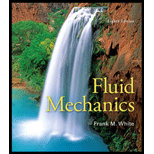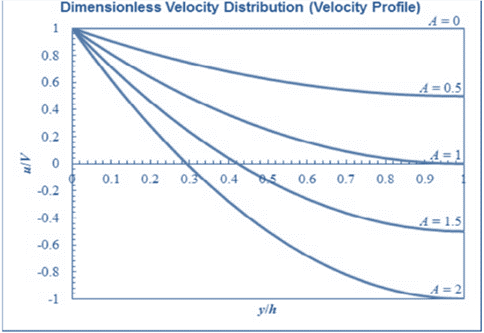
Concept explainers
(a)
Value of nonzero velocity,
Answer to Problem 4.2CP
The value of nonzero velocity is,
Explanation of Solution
Assume the flow to be parallel,
Due to this, the momentum equation along x and z directions can be neglected.
Consider the y momentum equation,
Substitute 0 for u, 0 for w, 0 for
Integrate the second-order linear differential equation with respect to y, it gives:
Δ
Integrate again gives:
Δ
By applying the 1st boundary condition,
Δ
By applying the2nd boundary conditions,
Δ
Substitute,
(b)
The average velocity
Answer to Problem 4.2CP
The average velocity is,
Explanation of Solution
Based on the knowledge of calculus, the average value on an interval [a,b] of an integrable function f is given by:
Likewise, the average velocity,
Therefore,
(c)
Velocity,
Answer to Problem 4.2CP
Velocity,
Explanation of Solution
With the relationship of the velocity distribution obtained in part (a), the equation of flow-rate per unit width, Q, can be formulated from relation,
Since, there is no net flow either up or down, therefore,
(d)
Sketch the
Explanation of Solution
The equation which describe the velocity distribution, u(y), which derived in part (a) can be expressed in dimensionless form by dividing both sides of the equation by the velocity, V.
Where,
The velocity distribution of the film at various y-location which has the domain range from
The results are tabulated below:
| x/h | u/V | ||||
| A=0 | A=0.5 | A=1 | A=1.5 | A=2 | |
| 0 | 1 | 1 | 1 | 1 | 1 |
| 0.05 | 1 | 0.95125 | 0.9025 | 0.85375 | 0.805 |
| 0.1 | 1 | 0.905 | 0.81 | 0.715 | 0.62 |
| 0.15 | 1 | 0.86125 | 0.7225 | 0.58375 | 0.445 |
| 0.2 | 1 | 0.82 | 0.64 | 0.46 | 0.28 |
| 0.25 | 1 | 0.78125 | 0.5625 | 0.34375 | 0.125 |
| 0.3 | 1 | 0.745 | 0.49 | 0.235 | -0.02 |
| 0.35 | 1 | 0.71125 | 0.4225 | 0.13375 | -0.155 |
| 0.4 | 1 | 0.68 | 0.36 | 0.04 | -0.28 |
| 0.45 | 1 | 0.65125 | 0.3025 | -0.04625 | -0.395 |
| 0.5 | 1 | 0.625 | 0.25 | -0.125 | -0.5 |
| 0.55 | 1 | 0.60125 | 0.2025 | -0.19625 | -0.595 |
| 0.6 | 1 | 0.58 | 0.16 | -0.26 | -0.68 |
| 0.65 | 1 | 0.56125 | 0.1225 | -0.31625 | -0.755 |
| 0.7 | 1 | 0.545 | 0.09 | -0.365 | -0.82 |
| 0.75 | 1 | 0.53125 | 0.0625 | -0.40625 | -0.875 |
| 0.8 | 1 | 0.52 | 0.04 | -0.44 | -0.92 |
| 0.85 | 1 | 0.51125 | 0.0225 | -0.46625 | -0.955 |
| 0.9 | 1 | 0.505 | 0.01 | -0.485 | -0.98 |
| 0.95 | 1 | 0.50125 | 0.0025 | -0.49625 | -0.995 |
| 1 | 1 | 0.5 | 0 | -0.5 | -1 |
Dimensionless Velocity Distribution (Velocity Profile):

As illustrated on the plot of velocity profile of fluid flow shown above, there are still some portions of the fluid flow downward (
Conclusion:
It can be concluded that in order to lift a fluid with small viscosity, a relatively large belt speed is required.
Want to see more full solutions like this?
Chapter 4 Solutions
Fluid Mechanics
- Auto Controls Hand sketch the root Focus of the following transfer function How many asymptotes are there ?what are the angles of the asymptotes?Does the system remain stable for all values of K NO COPIED SOLUTIONSarrow_forward-400" 150" in Datum 80" 90" -280"arrow_forwardUsing hand drawing both of themarrow_forward
- A 10-kg box is pulled along P,Na rough surface by a force P, as shown in thefigure. The pulling force linearly increaseswith time, while the particle is motionless att = 0s untilit reaches a maximum force of100 Nattimet = 4s. If the ground has staticand kinetic friction coefficients of u, = 0.6 andHU, = 0.4 respectively, determine the velocityof the A 1 0 - kg box is pulled along P , N a rough surface by a force P , as shown in the figure. The pulling force linearly increases with time, while the particle is motionless at t = 0 s untilit reaches a maximum force of 1 0 0 Nattimet = 4 s . If the ground has static and kinetic friction coefficients of u , = 0 . 6 and HU , = 0 . 4 respectively, determine the velocity of the particle att = 4 s .arrow_forwardCalculate the speed of the driven member with the following conditions: Diameter of the motor pulley: 4 in Diameter of the driven pulley: 12 in Speed of the motor pulley: 1800 rpmarrow_forward4. In the figure, shaft A made of AISI 1010 hot-rolled steel, is welded to a fixed support and is subjected to loading by equal and opposite Forces F via shaft B. Stress concentration factors K₁ (1.7) and Kts (1.6) are induced by the 3mm fillet. Notch sensitivities are q₁=0.9 and qts=1. The length of shaft A from the fixed support to the connection at shaft B is 1m. The load F cycles from 0.5 to 2kN and a static load P is 100N. For shaft A, find the factor of safety (for infinite life) using the modified Goodman fatigue failure criterion. 3 mm fillet Shaft A 20 mm 25 mm Shaft B 25 mmarrow_forward
 Elements Of ElectromagneticsMechanical EngineeringISBN:9780190698614Author:Sadiku, Matthew N. O.Publisher:Oxford University Press
Elements Of ElectromagneticsMechanical EngineeringISBN:9780190698614Author:Sadiku, Matthew N. O.Publisher:Oxford University Press Mechanics of Materials (10th Edition)Mechanical EngineeringISBN:9780134319650Author:Russell C. HibbelerPublisher:PEARSON
Mechanics of Materials (10th Edition)Mechanical EngineeringISBN:9780134319650Author:Russell C. HibbelerPublisher:PEARSON Thermodynamics: An Engineering ApproachMechanical EngineeringISBN:9781259822674Author:Yunus A. Cengel Dr., Michael A. BolesPublisher:McGraw-Hill Education
Thermodynamics: An Engineering ApproachMechanical EngineeringISBN:9781259822674Author:Yunus A. Cengel Dr., Michael A. BolesPublisher:McGraw-Hill Education Control Systems EngineeringMechanical EngineeringISBN:9781118170519Author:Norman S. NisePublisher:WILEY
Control Systems EngineeringMechanical EngineeringISBN:9781118170519Author:Norman S. NisePublisher:WILEY Mechanics of Materials (MindTap Course List)Mechanical EngineeringISBN:9781337093347Author:Barry J. Goodno, James M. GerePublisher:Cengage Learning
Mechanics of Materials (MindTap Course List)Mechanical EngineeringISBN:9781337093347Author:Barry J. Goodno, James M. GerePublisher:Cengage Learning Engineering Mechanics: StaticsMechanical EngineeringISBN:9781118807330Author:James L. Meriam, L. G. Kraige, J. N. BoltonPublisher:WILEY
Engineering Mechanics: StaticsMechanical EngineeringISBN:9781118807330Author:James L. Meriam, L. G. Kraige, J. N. BoltonPublisher:WILEY





